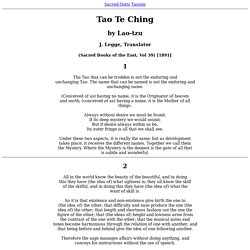

The daily tao - with frames. Wandering Daoists. Tao Te Ching by Lao Tzu - Taoism. About The Tao Te Ching. The Tao by Lao-tse. Tao Te Ching - Translated by J. Legge. The Tao that can be trodden is not the enduring and unchanging Tao.

The name that can be named is not the enduring and unchanging name. (Conceived of as) having no name, it is the Originator of heaven and earth; (conceived of as) having a name, it is the Mother of all things. Always without desire we must be found, If its deep mystery we would sound; But if desire always within us be, Its outer fringe is all that we shall see. Under these two aspects, it is really the same; but as development takes place, it receives the different names. Together we call them the Mystery. All in the world know the beauty of the beautiful, and in doing this they have (the idea of) what ugliness is; they all know the skill of the skilful, and in doing this they have (the idea of) what the want of skill is.
Therefore the sage manages affairs without doing anything, and conveys his instructions without the use of speech. The work is done, but how no one can see; 'Tis this that makes the power not cease to be. Tao Te Ching. Tao Te Ching. The Tao Te Ching,[1] Daodejing, or Dao De Jing (simplified Chinese: 道德经; traditional Chinese: 道德經; pinyin: Dàodéjīng), also simply referred to as the Laozi (Chinese: 老子; pinyin: Lǎozǐ),[2][3] is a Chinese classic text.

According to tradition, it was written around 6th century BC by the sage Laozi (or Lao Tzu, Chinese: 老子; pinyin: Lǎozǐ, literally meaning "Old Master"), a record-keeper at the Zhou dynasty court, by whose name the text is known in China. The text's true authorship and date of composition or compilation are still debated,[4] although the oldest excavated text dates back to the late 4th century BC.[2] The Wade–Giles romanization "Tao Te Ching" dates back to early English transliterations in the late 19th century; its influence can be seen in words and phrases that have become well established in English.
"Daodejing" is the pinyin romanization. Text[edit] The Tao Te Ching has a long and complex textual history. Title[edit] Internal structure[edit] Principal versions[edit] Alan Watts Lectures and Essays. AlanWatts.net. Alan Watts. Winnie the Pooh - The Tao of Pooh. Winnie the Pooh has a certain way about him, a way of doing things which has made him the world's most beloved bear.

And Pooh's Way, as Benjamin Hoff brilliantly demonstrates, seems strangely close to the ancient Chinese principles of Taoism. The 'Tao of Pooh' explains Taoism by Winnie the Pooh and explains Winnie the Pooh by Taoism. It makes you understand what A.A. Milne probably meant when he said he didn't write the Pooh-books for children in the first place. Over the centuries, Taoism classic teachings were developed and divided into philosophical, monastic, and folk religious forms.
One of the basic principles of Taoism is P'U; the Uncarved Block. Owl instead, is the opposite of Pooh, the Knowledge for the sake of Appearing Wise, the one who studies Knowledge for the sake of Knowledge, and who keeps what he learns to himself or to his own small group, rather than working for the enlightenment of others. "A fish can't whistle and neither can I. " Taoism Directory. Akira Rabelais Book of Changes. Alan Watts.